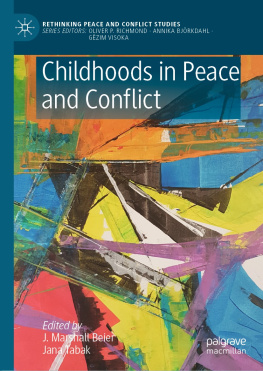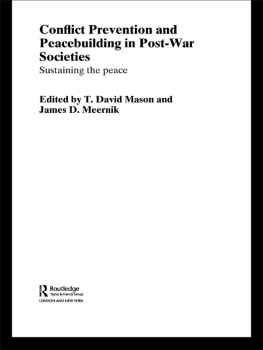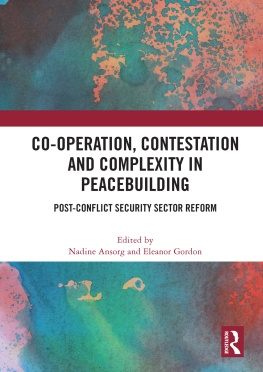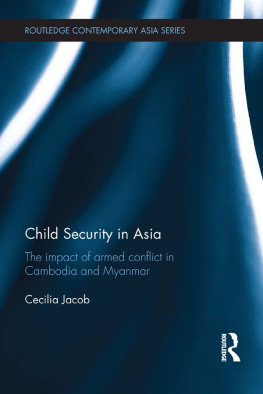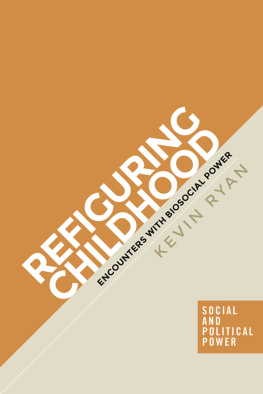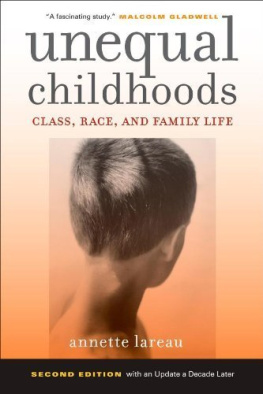Rethinking Peace and Conflict Studies
Series Editors
Oliver P. Richmond
University of Manchester, Manchester, UK
Annika Bjrkdahl
Department of Political Science, Lund University, Lund, Sweden
Gzim Visoka
Dublin City University, Dublin, Ireland
This agenda-setting series of research monographs, now more than a decade old, provides an interdisciplinary forum aimed at advancing innovative new agendas for peace and conflict studies in International Relations. Many of the critical volumes the series has so far hosted have contributed to new avenues of analysis directly or indirectly related to the search for positive, emancipatory, and hybrid forms of peace. Constructive critiques of liberal peace, hybrid peace, everyday contributions to peace, the role of civil society and social movements, international actors and networks, as well as a range of different dimensions of peace (from peacebuilding, statebuilding, youth contributions, photography, and many case studies) have been explored so far. The series raises important political questions about what peace is, whose peace and peace for whom, as well as where peace takes place. In doing so, it offers new and interdisciplinary perspectives on the development of the international peace architecture, peace processes, UN peacebuilding, peacekeeping and mediation, statebuilding, and localised peace formation in practice and in theory. It examines their implications for the development of local peace agency and the connection between emancipatory forms of peace and global justice, which remain crucial in different conflict-affected regions around the world. This series contributions offer both theoretical and empirical insights into many of the world's most intractable conflicts, also investigating increasingly significant evidence about blockages to peace.
More information about this series at http://www.palgrave.com/gp/series/14500
Editors
J. Marshall Beier and Jana Tabak
Childhoods in Peace and Conflict
1st ed. 2021

Logo of the publisher
Editors
J. Marshall Beier
Department of Political Science, McMaster University, Hamilton, ON, Canada
Jana Tabak
Department of International Relations, State University of Rio de Janeiro, Rio de Janeiro, Brazil
Rethinking Peace and Conflict Studies
ISBN 978-3-030-74787-9 e-ISBN 978-3-030-74788-6
https://doi.org/10.1007/978-3-030-74788-6
The Editor(s) (if applicable) and The Author(s), under exclusive license to Springer Nature Switzerland AG 2021
This work is subject to copyright. All rights are solely and exclusively licensed by the Publisher, whether the whole or part of the material is concerned, specifically the rights of translation, reprinting, reuse of illustrations, recitation, broadcasting, reproduction on microfilms or in any other physical way, and transmission or information storage and retrieval, electronic adaptation, computer software, or by similar or dissimilar methodology now known or hereafter developed.
The use of general descriptive names, registered names, trademarks, service marks, etc. in this publication does not imply, even in the absence of a specific statement, that such names are exempt from the relevant protective laws and regulations and therefore free for general use.
The publisher, the authors and the editors are safe to assume that the advice and information in this book are believed to be true and accurate at the date of publication. Neither the publisher nor the authors or the editors give a warranty, expressed or implied, with respect to the material contained herein or for any errors or omissions that may have been made. The publisher remains neutral with regard to jurisdictional claims in published maps and institutional affiliations.
This Palgrave Macmillan imprint is published by the registered company Springer Nature Switzerland AG
The registered company address is: Gewerbestrasse 11, 6330 Cham, Switzerland
For the young people navigating peace and conflict
Acknowledgments
A debt of gratitude is owed to the many people without whom this volume would not have been possible. As with all such projects, it is founded on the strength of vast and intricate webs of relationships that exceed the possibility of their being mapped. Not least among these are the connections (whether literal or figurative) that oftentimes bind us to those about whom we research and write. They include also the growing number of colleagues working at the emerging nexus between Critical Childhood Studies and Peace and Conflict Studies, Critical Security Studies, and disciplinary International Relations more broadly. From the outset, we have benefitted from the insights and encouragement of students and colleagues alike. Like those further afield in the vibrant and expanding networks of scholarship, activism, and communities of practice around issues of children and childhoods in varied contexts of peace and conflict, valued members of our home departments bear special mention for their interest in and support of our work on this and other projects. It simply is not possible to recognize everyone we would like to here, but all have left indelible impressions with their ideas, perspectives, support, and encouragement. We continue to learn from our participation in these networks and hope to contribute to them in return.
In more direct connection with the book itself, we are grateful to the contributors for answering our initial open call for papers with original and deeply intriguing proposals, for following through on the submission of full chapters that delivered on this promise, and for carrying out revisions to schedule while juggling the many new and competing demands occasioned by a global pandemic. Challenging times beget changing expectations around commitments earlier made and we recognize the extraordinary effort needed in many cases to follow through in spite of them. It has been our genuine pleasure to work with and learn from each of you through this process and we look forward to continuing conversations with hopes of further collaborations in the future.
We are very pleased to have the volume included in the Rethinking Peace and Conflict Studies series and thank the series editors, Oliver P. Richmond, Annika Bjrkdahl, and Gzim Visoka, for their support and for drawing the book into such good company. At Palgrave, Anca Pusca and Katelyn Zingg ushered our proposal through the process of approval and acceptance, while two anonymous reviewers for Palgrave gave excellent and engaged feedback from which we have all gained much. We are grateful to them all for their enthusiasm, their clear and supportive editorial guidance, and for input into the framing and scope of the volumethe final product is much stronger for all of it. Ashwini Elango provided excellent project coordination, seeing us through the production process and to publication swiftly and professionally.
And, as always, we are indebted to our families. Their love and support, their patience as we tend to commitments, and the often-profound insights they inspire are contributions in their own right, in this and in all else we do.
January 2021

